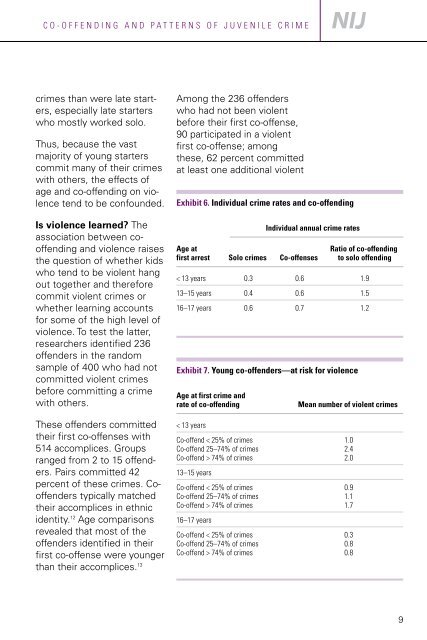Co-Offending and Patterns of Juvenile Crime - justice studies
Co-Offending and Patterns of Juvenile Crime - justice studies
Co-Offending and Patterns of Juvenile Crime - justice studies
Create successful ePaper yourself
Turn your PDF publications into a flip-book with our unique Google optimized e-Paper software.
C O - O F F E N D I N G A N D P A T T E R N S O F J U V E N I L E C R I M E<br />
crimes than were late starters,<br />
especially late starters<br />
who mostly worked solo.<br />
Thus, because the vast<br />
majority <strong>of</strong> young starters<br />
commit many <strong>of</strong> their crimes<br />
with others, the effects <strong>of</strong><br />
age <strong>and</strong> co-<strong>of</strong>fending on violence<br />
tend to be confounded.<br />
Is violence learned? The<br />
association between co<strong>of</strong>fending<br />
<strong>and</strong> violence raises<br />
the question <strong>of</strong> whether kids<br />
who tend to be violent hang<br />
out together <strong>and</strong> therefore<br />
commit violent crimes or<br />
whether learning accounts<br />
for some <strong>of</strong> the high level <strong>of</strong><br />
violence. To test the latter,<br />
researchers identified 236<br />
<strong>of</strong>fenders in the r<strong>and</strong>om<br />
sample <strong>of</strong> 400 who had not<br />
committed violent crimes<br />
before committing a crime<br />
with others.<br />
Among the 236 <strong>of</strong>fenders<br />
who had not been violent<br />
before their first co-<strong>of</strong>fense,<br />
90 participated in a violent<br />
first co-<strong>of</strong>fense; among<br />
these, 62 percent committed<br />
at least one additional violent<br />
Exhibit 6. Individual crime rates <strong>and</strong> co-<strong>of</strong>fending<br />
Individual annual crime rates<br />
Age at<br />
Ratio <strong>of</strong> co-<strong>of</strong>fending<br />
first arrest Solo crimes <strong>Co</strong>-<strong>of</strong>fenses to solo <strong>of</strong>fending<br />
< 13 years 0.3 0.6 1.9<br />
13–15 years 0.4 0.6 1.5<br />
16–17 years 0.6 0.7 1.2<br />
Exhibit 7. Young co-<strong>of</strong>fenders—at risk for violence<br />
Age at first crime <strong>and</strong><br />
rate <strong>of</strong> co-<strong>of</strong>fending<br />
Mean number <strong>of</strong> violent crimes<br />
These <strong>of</strong>fenders committed < 13 years<br />
their first co-<strong>of</strong>fenses with <strong>Co</strong>-<strong>of</strong>fend < 25% <strong>of</strong> crimes 1.0<br />
514 accomplices. Groups <strong>Co</strong>-<strong>of</strong>fend 25–74% <strong>of</strong> crimes 2.4<br />
ranged from 2 to 15 <strong>of</strong>fend- <strong>Co</strong>-<strong>of</strong>fend > 74% <strong>of</strong> crimes<br />
2.0<br />
ers. Pairs committed 42<br />
13–15 years<br />
percent <strong>of</strong> these crimes. <strong>Co</strong>- <strong>Co</strong>-<strong>of</strong>fend < 25% <strong>of</strong> crimes 0.9<br />
<strong>of</strong>fenders typically matched <strong>Co</strong>-<strong>of</strong>fend 25–74% <strong>of</strong> crimes 1.1<br />
their accomplices in ethnic <strong>Co</strong>-<strong>of</strong>fend > 74% <strong>of</strong> crimes<br />
1.7<br />
identity. 12 Age comparisons 16–17 years<br />
revealed that most <strong>of</strong> the <strong>Co</strong>-<strong>of</strong>fend < 25% <strong>of</strong> crimes 0.3<br />
<strong>of</strong>fenders identified in their <strong>Co</strong>-<strong>of</strong>fend 25–74% <strong>of</strong> crimes 0.8<br />
first co-<strong>of</strong>fense were younger <strong>Co</strong>-<strong>of</strong>fend > 74% <strong>of</strong> crimes<br />
0.8<br />
than their accomplices. 13 9





